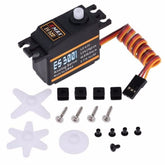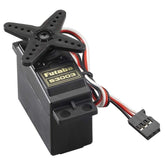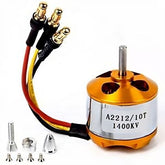Top 10 Servo Motor Applications in Industry and Daily Life
Summary
A servo motor stands out as a vital component in modern engineering and automation, offering precise control for a variety of applications.
From high-tech manufacturing to everyday gadgets, the applications of servo motor are impressively widespread, making them indispensable in both industry and daily life.

What Is a Servo Motor?
A servo motor is an electromechanical device designed to provide precise control over angular or linear position, velocity, and acceleration. It integrates a motor, feedback sensors, and a control system, allowing it to adjust its movement continuously based on input signals and sensor feedback.
This makes it far more accurate than standard motors, especially where precise positioning is required.
How Do Servo Motors Work?
Servo motors work using a closed-loop system. The essential components include a motor (either AC or DC), a position sensor (often a potentiometer or encoder), a control circuit, and a gear assembly.

The control circuit compares the desired position (from input signals) with the actual position (from the sensor). If there’s a discrepancy, the motor is driven to correct the difference until the shaft reaches the exact position required.
Controlling a servo motor is typically done via pulse width modulation (PWM). The width of the pulse sent to the motor determines the angle at which the shaft rotates—shorter pulses for one end of the range, longer pulses for the other. This allows for smooth, accurate movement, making servo motors ideal for tasks requiring fine control.
Types of Servo Motors
Servo motors are primarily divided into two main types:

AC Servo Motors: This use alternating current and are found in high-speed, high-precision applications like CNC machines and robotics. They are known for their smooth operation and reliability.
DC Servo Motors: These run on DC power and are common in robotics, consumer electronics, and small-scale automation. They are generally easier to control but may have limitations in speed and torque compared to AC types.
Top 10 Servo Motor Applications in Industry and Daily Life
The applications of servo motor span a wide range, from heavy manufacturing to simple household devices. Here are some of the most notable uses:
- Robotics: Servo motors control robotic arms, enabling precise movements for tasks like picking, placing, welding, and assembly. Their accuracy is crucial in automation and advanced manufacturing.
- Industrial Automation: In production lines, servo motors drive conveyors, feeders, loaders, and unloaders, ensuring synchronized and efficient processes. Their repeatability increases productivity and quality.
- Printing and Scanning: Servo motors manage print head and scanner head movements, ensuring accurate placement for high-quality prints and scans.
- CNC Machines: In machines like CNC lathes and milling machines, servo motors provide the precise control needed for cutting, drilling, and engraving tasks.
- Aerospace: Servo motors control aircraft components such as flaps, rudders, and ailerons, offering reliable motion control for safer and more efficient flight operations.
- Medical Devices: Surgical robots, diagnostic equipment, ventilators, and pumps use servo motors for their precise and controllable movements, which are essential for patient care.
- Conveyor Belts: Servo motors synchronize the speed and position of conveyor belts, ensuring smooth flow of products in packaging and sorting lines.
- Camera and Surveillance Systems: In security cameras, servo motors adjust pan and tilt features, enabling accurate tracking and monitoring of areas.
- Antenna Positioning: In satellite and radar systems, servo motors help position antennas for optimal signal transmission and reception, crucial for communication networks.
- Automotive Manufacturing: Servo motors are used in assembly line operations, welding, and painting, ensuring precise and consistent movements in vehicle production.
These practical examples of servo motor usage illustrate how servo motors are embedded in our daily lives; from the cars we drive to the medical devices that keep us healthy. The servo motor uses are as diverse as the industries they serve, making them a cornerstone of modern technology.
Servo Motor vs DC Motor vs BO Motor
| Feature | Servo Motor | DC Motor | BO Motor |
|---|---|---|---|
| Control System | Closed-loop | Open-loop | Open-loop |
| Precision | High | Low to Moderate | Low |
| Speed Range | Wide | Wide | Narrow |
| Power Output | Moderate to High | High | Low |
| Best Use Case | Positioning | Continuous Rotation | Simple Tasks |
| Feedback Mechanism | Encoder / Potentiometer | None | None |
This table highlights why servo motors are preferred in applications requiring precise control and feedback, while DC and BO motors are used for simpler, less precise tasks.
Advantages of Using Servo Motors
The main advantages of servo motors include:
- High precision and repeatability in positioning tasks.
- Wide speed range and excellent control over acceleration and torque.
- Reliability and ability to handle heavy loads in demanding environments.
- Versatility, making them suitable for both industrial and consumer applications.
Limitations of Servo Motors
Servo motors also have some drawbacks:
- Higher cost compared to standard motors.
- Complex control circuitry required for effective operation.
- Limited power output in some models, especially micro servo motors.
Conclusion
Servo motors are a key part of modern automation and technology, offering unmatched precision and reliability. Their applications of servo motor are vast, touching everything from manufacturing to healthcare.
As technology advances, servo motors will continue to play a vital role in shaping efficient and intelligent systems across industries.

















